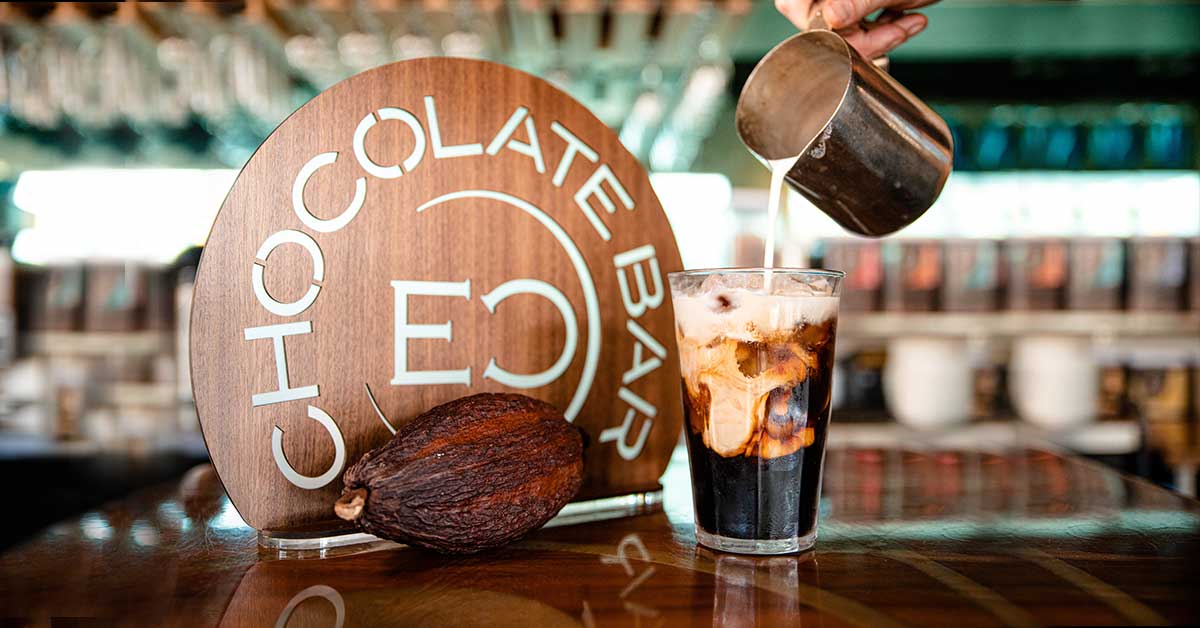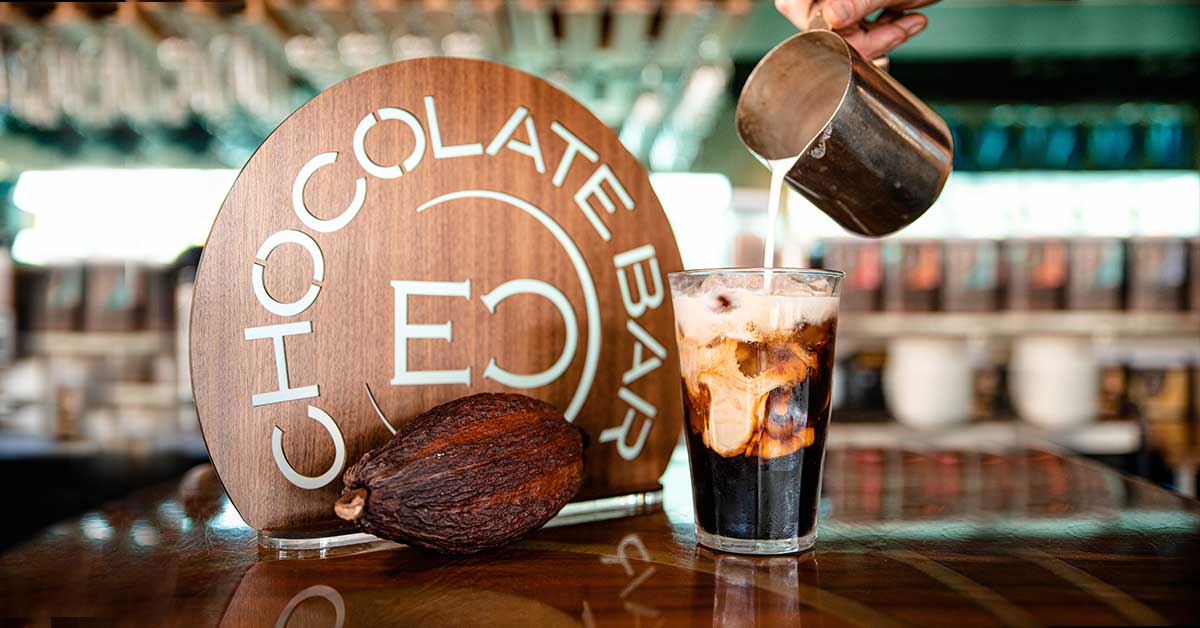
From art historian to chocolate maker, Daniel Youngren and his partner William Gustwiller began their chocolate-making journey with Eclipse Chocolate, a chocolate shop turned restaurant in 2004. The adventure kicked off from their very own home and eventually grew into what is now their 4000 square foot location in California.
Their love of art and chocolate brought to fruition a restaurant and chocolate shop that would withstand exceptional challenges like a recession and a global pandemic. By thinking on their feet, repurposing their products and pivoting their restaurant into a grocery, they were able to tackle the many curveballs that came their way in 2020. Throughout the years, Youngren and Gustwiller have proved themselves to be the praiseworthy, resilient chocolatiers the hospitality world needs.
We interviewed Eclipse Chocolate owner, Daniel Youngren, to find out more about the twists and turns in their hospitality journey.
Get your restaurant ready for the future of dining
With 2020 behind us, restaurateurs need to look to the future, stay ahead of trends and adopt the digital strategies that kept retailers selling through last year’s unprecedented challenges. Find out how to help your business thrive in the new era of hospitality with our guide.
Tell us about your background and beginnings. How did Eclipse Chocolate get started?
Eclipse Chocolate was started by my partner, Will Gustwiller. He and I both have an art background. He’s more fine arts, jewelry, metal smithing, and I’m more the history side of art. So our powers have kind of combined through chocolate since we both wanted to be involved in art. The jewelry, metal smithing and art world in general is pretty tough. Then again, so is the restaurant world, but it’s a much more delicious kind of industry.
We started in 2004 as kind of an expression of a love for art. And gosh, I can’t believe we just celebrated our 15th anniversary in 2019 through 2020. We started originally as a chocolatier. We were originally based out of home. Once it started to really take off, we got our own space in a smaller dessert cafe before relaunching about six years ago. That was a big, big, big shift for us. We went from being just a small dessert cafe, occasionally doing pop up dinners, really concentrating still on chocolate manufacturing to a 4,000 square foot space with a patio and event room, with seating for about 120 guests—much more of a leaning into manufacturing of food. And of course, with COVID, that’s really radically changed everything again, since we weren’t able to have guests.
We’re all very much self-taught. When we started, we were really oblivious about what was going on and just the scope and magnitude of the recession at the time. Thankfully, we were so small that somehow we were able to navigate through that without going out of business. We were experiencing so much growth and we just needed more space. There was so much opportunity for growth by leaning into a dining concept. We probably bit off a lot more than we could chew in some ways, but here we are.
Wow, that’s quite the upgrade. Now that you had a larger space and a dining concept, how were you able to take on the changes of 2020?
The biggest unexpected twist of 2020 for us was the day in mid March when we were notified that dining of any kind was shutting down. We had no choice but to change. We cleared away our furniture, brought out most of the kind of food that we have in stock as food manufacturers and we still had so many things in stock because we were a bakery. With the bread making craze, we knew people could find something delicious to make at home, try something new or learn a new skill. They couldn’t find a lot of these basic ingredients. So we were able to provide those. More recently, as the grocery panic subsided, we took on a lot of artisan food brands. You’ll see shelves of exotic bath products, soaps, spa goods and self care items, and even curry pastes and mixers for cocktails. 2020 was a lot of necessary changes to get food to people.
Tell us a bit more about the process of starting the grocery store. Is it now a permanent part of the business?
We’ve always had small partners locally, like coffee roasters or other makers of delicious things that we can sell. We know, for example, chemists who work in the local chemistry industry that are also makers of soap or candles and so they can use their skills in other ways.
We’ve had those kinds of partners for many years and been selling their goods. This has been a really great opportunity to connect with all sorts of small companies, usually maybe a husband and wife pair or family or a co-op, usually very small scale companies that are also really hurting from COVID. We can shop with them and connect their goods with our customers as well. We’ve been able to connect with a much larger kind of community of artisan producers and we don’t expect that to change.
We do have these options that other restaurants in our community weren’t prepared for or weren’t licensed for. Since we make chocolate, we have different licensing than our restaurant peers. Overall, it’s been a really unique experience for sure.
Did you end up opening at any point last year?
There was a period where dining inside with a lot of restrictions about spacing was allowed. But we didn’t do that because we had already configured our space as a grocery store. Also at the time, we weren’t all that confident on how safe that was and there’s a lot of expense involved in setting up for indoor service as well. So taking that on was a bit too much to ask.
Did you continue operating the restaurant alongside the grocery in some way?
We were allowed to take delivery the entire time for dining. It fluctuated between being able to dine inside or outside for us. We only allowed dining outside in a very much socially distanced capacity with about, say, 12 to 15 people at a time maximum. We’ve been seeing most of our business from to-go and delivery, from retail, for groceries and for these artisan food gifts, of course chocolate and a lot of ordering online as well. We were doing delivery and takeaway before, but not to this degree.
The closest thing that we had to a grocery concept was our own artisan food that we were often packaging. So, for example, ingredients like chocolates or exotic salts and sugars and that kind of thing, we were set up as a grocery in a very minimal way before COVID struck just as a natural byproduct of a bakery and a food maker. We already had a little category on Lightspeed called grocery and we had our website as well, so we were largely set up in March—just one of the lucky ones out of all this.
What new things have you implemented?
The area that we’ve moved into is frozen meals, which can also be delivered or shipped anywhere in the country or picked up from our freezer, because with so much unpredictability when it comes to the restaurant, we can put a lot of our effort into meals that are more stable for folks to simply order through our website or pick up.
With our frozen meals sometimes there are some variations on favorite items for our menu. Sometimes they’re requests from our customers that have specific dietary needs. Sometimes it’s just us getting really creative since it’s such a weird environment. That’s a good place for us to put a lot of our energy into looking at what people are craving.
Did you make any specific shifts to your menu to make foods more delivery-friendly?
I think every restaurant can agree that when you do add delivery to the equation, it changes the picture entirely. On the one hand, financially, there’s this problem that the pie is already very finite in size and it’s already divided into so many slices. And the profitability of a restaurant is already so slim. Adding takeaway to the equation with the fees that they assess makes it very challenging and it makes it even more important to be 100 percent accurate every time, which realistically isn’t even possible. So, yes, we had to change our menu. In March we were already delivering most of our menu, but operationally, we knew that we had to really focus and only hold on to dishes that were essentially foolproof. Once it leaves our building, there’s so much trust placed that it’s going to be treated with the care that we would give it. It’s just one sharp press of the breaks that can send eggs flying off of the Benedicts. I know for a fact our customers are just wonderfully gracious people. I’m confident that things have gone wrong and I’m just very grateful that people have been very gracious.
Did you implement dining experiences that people could prepare in their homes?
We’ve been really leaning into the direction of meal kits, frozen meals and box formats for a family scale dining experience, as well as tastings that we can conduct on Zoom or other other online venues. Basically this branch of concepts includes frozen meals that are super easy, that you can just throw in an oven at 350 degrees and you’re set within 30, 40 minutes. We designed that mostly for families, individuals and couples that are just burned out on cooking. These are super delicious, foolproof, easy, wonderful meals.
Another big area would be our brunch boxes and our artisan cheese boxes and things like that that are prepared foods that are presented in a kind of small format, catering style so we can deliver that to someone’s door and it can be shipped. People can pick it up from our curbside for a contactless pickup where it’s hot off our griddle, right out of our oven and ready to go. That stems from our previous event catering that we were doing. But of course, without events this is our only real option to have an event for your family.
We’ve also been doing some very cool special event packages as well. For example, for the holidays, we had a combination of frozen items with some like light preparation that you could do at home so you could still have that kind of cooking at home experience without really any of the horrible stress of dealing with 50 moving parts for a holiday meal. We would have taken care of 95 percent of it and just left like the final plating and final touches. So you can still have the “I cooked the Christmas dinner experience” without the mess.
We also had our Zoom tastings where we had a really fun experience teaching people about chocolate, walking through making chocolate and doing the anatomy of a truffle so people can really have an understanding of what this is.
Wow you really got creative! How was technology able to support you throughout all these changes? Talk to us a little about your experience with Lightspeed.
We’ve been using Lightspeed for over seven years now and it’s been great. Originally we were using one of your competitors and it wasn’t offering the kind of functionality that we needed. There were back end processing issues that were really problematic for us. Lightspeed was really easy to set up for our unique menu especially like the choice-based and combo-based options and dividing up things neatly really worked for our concept.
We were having a bear of a time finding a system that would allow us to simply just build up to include the kinds of discounts and customization features that we wanted. Once we got that set up with shockingly very little trial and error, we were able to get that all configured and now have maybe seven or eight categories to cover all of the many different things that we offer. It’s very stable. We use the version that includes the on-site server—it’s proven to be a very wise investment. It wasn’t that much of an upfront cost in comparison to the massive headaches of a system-wide crash that we were having with other systems. With Lightspeed offering the offsite backup as well as the on site backup, I haven’t had to cycle our power, or our routers like I used to. We don’t have those things crashing during busy service periods. The stability and the customization have been fantastic.
When it came to pivoting mid-March to become a grocery store, like I mentioned, we already had a category with 15 or 20 items in it. It was really just a matter of going through and adding all those items that we wanted to sell and we were ready to go. Whereas I’m sure the other restaurants that are using other industry standards, I don’t know if they’d have the same ease to just adapt. We’re still using the restaurant program.
How do you feel about the future of hospitality? What are your thoughts on what the future has in store?
Our culture’s relationship with food is transforming in a way that restaurants may not be able to exist in the way that we recognize them. The idea of a restaurant, as we currently have it, is very recent in our history. And it’s subject to change. I think, as a nerdy historian, my biggest lesson to pass to everyone is that we are always living in historical times and we’re not immune to the changes of history. The idea that we’ll come through this and we’ll still have restaurants isn’t something that we should necessarily take for granted, because there’s so many. In California, there are so many burdens on employers of all kinds already and so much competition for an already divided pie where there’s very little piece of profit left. With meal delivery and third-party platforms, they are working to make their money, too and they’re trying to take from that pie, understandably. But at a certain point, there’s no pie. There’s no pie for anyone.
People have been gathering around food throughout our entire history as a species. That’s just part of who we are as humans. We gather around food. It’s just a question of what that space is going to look like. Is it going to be outside only or maybe the restaurant will just look really radically different. They probably will. I know that I can’t wait to hang out with people again.
Experimenting in the new age of hospitality
For Youngren, some things in the hospitality industry are still the same. “Something that has not changed about the restaurant industry is that food is largely about experimentation and sometimes it works and sometimes it doesn’t. You learn from these experiences. We definitely learned a lot,” adds Youngren. While the restaurant industry is continually changing, it’s always been an industry of innovation. Passionate restaurateurs like Eclipse Chocolate, that are willing to rise up to the challenges and meet the future head-on, are part of the new age of hospitality, ready to bring excitement and innovation to the kitchen table.
Is your restaurant ready to meet the new age of hospitality? Talk to one of our experts to find out how Lightspeed can help.
Looking For Restaurant Billing Solution?
Call Pursho @ 0731-6725516
Telegram Group One Must Follow :
For Startups: https://t.me/daily_business_reads
#Art #Hospitality #Eclipse #Chocolate #Turned #Restaurant #Grocery #Store







